wheel FIAT BARCHETTA 2003 1.G Owners Manual
[x] Cancel search | Manufacturer: FIAT, Model Year: 2003, Model line: BARCHETTA, Model: FIAT BARCHETTA 2003 1.GPages: 170, PDF Size: 3.55 MB
Page 8 of 170
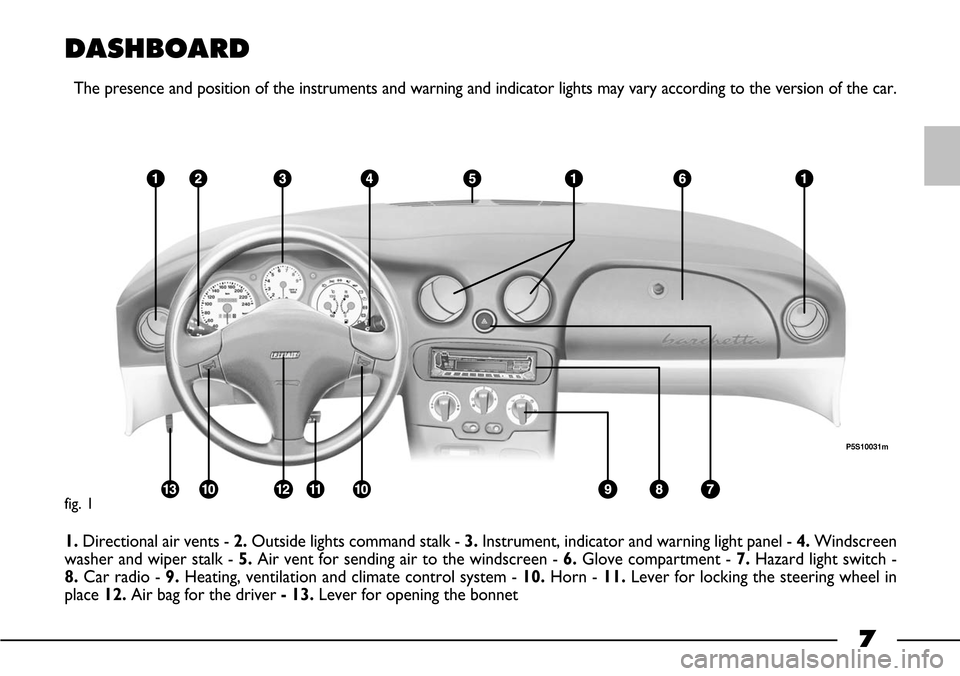
7
DASHBOARD
The presence and position of the instruments and warning and indicator lights may vary according to the version of the car.
1.Directional air vents -2.Outside lights command stalk - 3.Instrument, indicator and warning light panel - 4.Windscreen
washer and wiper stalk -5.Air vent for sending air to the windscreen - 6. Glove compartment -7.Hazard light switch -
8. Car radio - 9. Heating, ventilation and climate control system - 10.Horn - 11.Lever for locking the steering wheel in
place 12. Air bag for the driver - 13.Lever for opening the bonnet
fig. 1
P5S10031m
Page 19 of 170
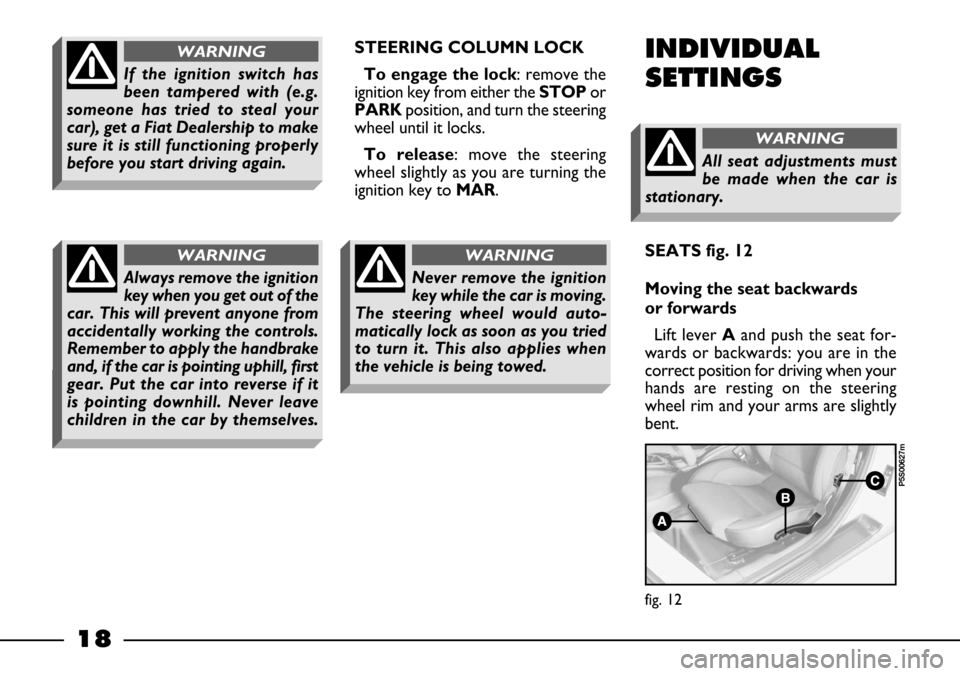
18
If the ignition switch has
been tampered with (e.g.
someone has tried to steal your
car), get a Fiat Dealership to make
sure it is still functioning properly
before you start driving again.
WARNING
Always remove the ignition
key when you get out of the
car. This will prevent anyone from
accidentally working the controls.
Remember to apply the handbrake
and, if the car is pointing uphill, first
gear. Put the car into reverse if it
is pointing downhill. Never leave
children in the car by themselves.
WARNING
STEERING COLUMN LOCK
To engage the lock: remove the
ignition key from either theSTOP or
PARKposition, and turn the steering
wheel until it locks.
To release: move the steering
wheel slightly as you are turning the
ignition key to MAR.INDIVIDUAL
SETTINGS
All seat adjustments must
be made when the car is
stationary.
WARNING
SEATS fig. 12
Moving the seat backwards
or forwards
Lift lever Aand push the seat for-
wards or backwards: you are in the
correct position for driving when your
hands are resting on the steering
wheel rim and your arms are slightly
bent.
fig. 12
P5S00627m
Never remove the ignition
key while the car is moving.
The steering wheel would auto-
matically lock as soon as you tried
to turn it. This also applies when
the vehicle is being towed.
WARNING
Page 20 of 170
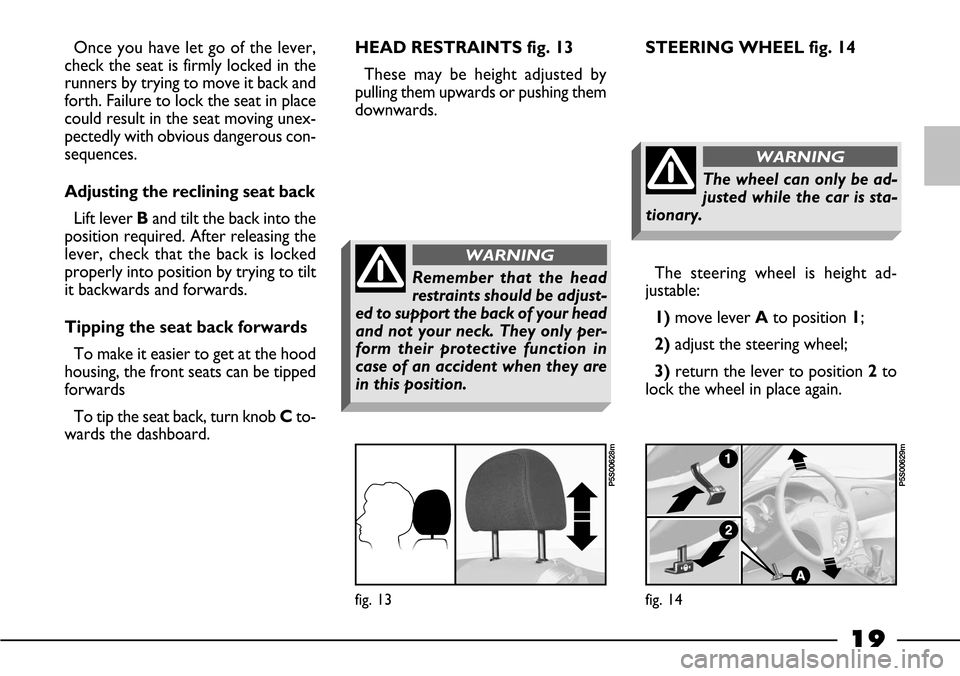
19
Once you have let go of the lever,
check the seat is firmly locked in the
runners by trying to move it back and
forth. Failure to lock the seat in place
could result in the seat moving unex-
pectedly with obvious dangerous con-
sequences.
Adjusting the reclining seat back
Lift lever Band tilt the back into the
position required. After releasing the
lever, check that the back is locked
properly into position by trying to tilt
it backwards and forwards.
Tipping the seat back forwards
To make it easier to get at the hood
housing, the front seats can be tipped
forwards
To tip the seat back, turn knob Cto-
wards the dashboard.HEAD RESTRAINTS fig. 13
These may be height adjusted by
pulling them upwards or pushing them
downwards.STEERING WHEEL fig. 14
The wheel can only be ad-
justed while the car is sta-
tionary.
WARNING
The steering wheel is height ad-
justable:
1)move lever Ato position 1;
2) adjust the steering wheel;
3) return the lever to position2to
lock the wheel in place again.
fig. 13
P5S00628m
fig. 14
P5S00629m
Remember that the head
restraints should be adjust-
ed to support the back of your head
and not your neck. They only per-
form their protective function in
case of an accident when they are
in this position.
WARNING
Page 32 of 170
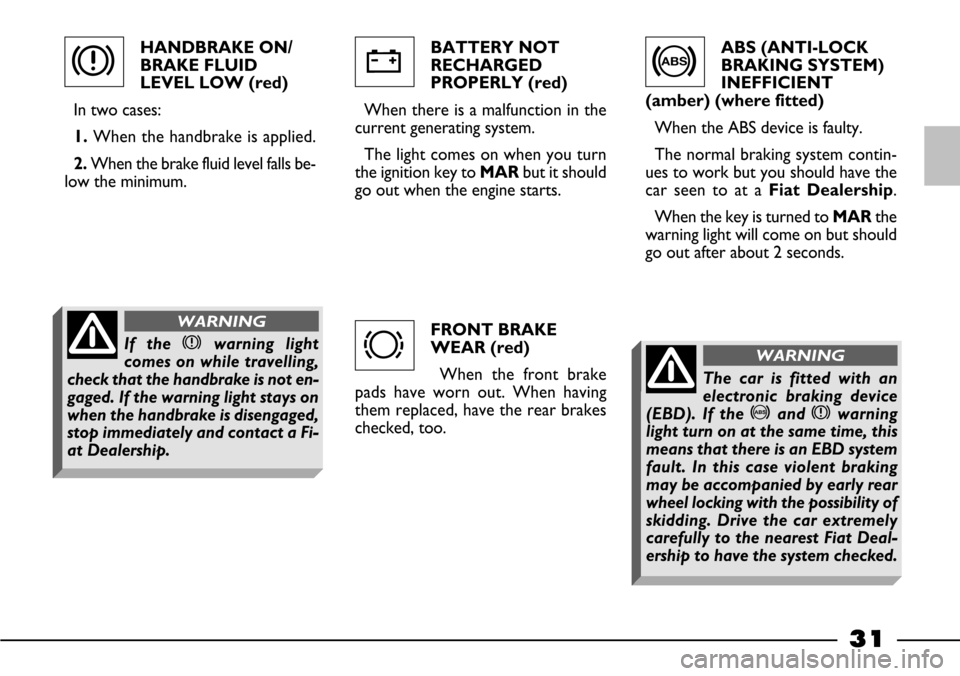
ABS (ANTI-LOCK
BRAKING SYSTEM)
INEFFICIENT
(amber) (where fitted)
When the ABS device is faulty.
The normal braking system contin-
ues to work but you should have the
car seen to at a Fiat Dealership.
When the key is turned toMARthe
warning light will come on but should
go out after about 2 seconds. HANDBRAKE ON/
BRAKE FLUID
LEVEL LOW (red)
In two cases:
1. When the handbrake is applied.
2. When the brake fluid level falls be-
low the minimum.BATTERY NOT
RECHARGED
PROPERLY (red)
When there is a malfunction in the
current generating system.
The light comes on when you turn
the ignition key to MARbut it should
go out when the engine starts.
FRONT BRAKE
WEAR (red)
When the front brake
pads have worn out. When having
them replaced, have the rear brakes
checked, too.
31
w>
d
x
If the xwarning light
comes on while travelling,
check that the handbrake is not en-
gaged. If the warning light stays on
when the handbrake is disengaged,
stop immediately and contact a Fi-
at Dealership.
WARNING
The car is fitted with an
electronic braking device
(EBD). If the >and xwarning
light turn on at the same time, this
means that there is an EBD system
fault. In this case violent braking
may be accompanied by early rear
wheel locking with the possibility of
skidding. Drive the car extremely
carefully to the nearest Fiat Deal-
ership to have the system checked.
WARNING
Page 39 of 170
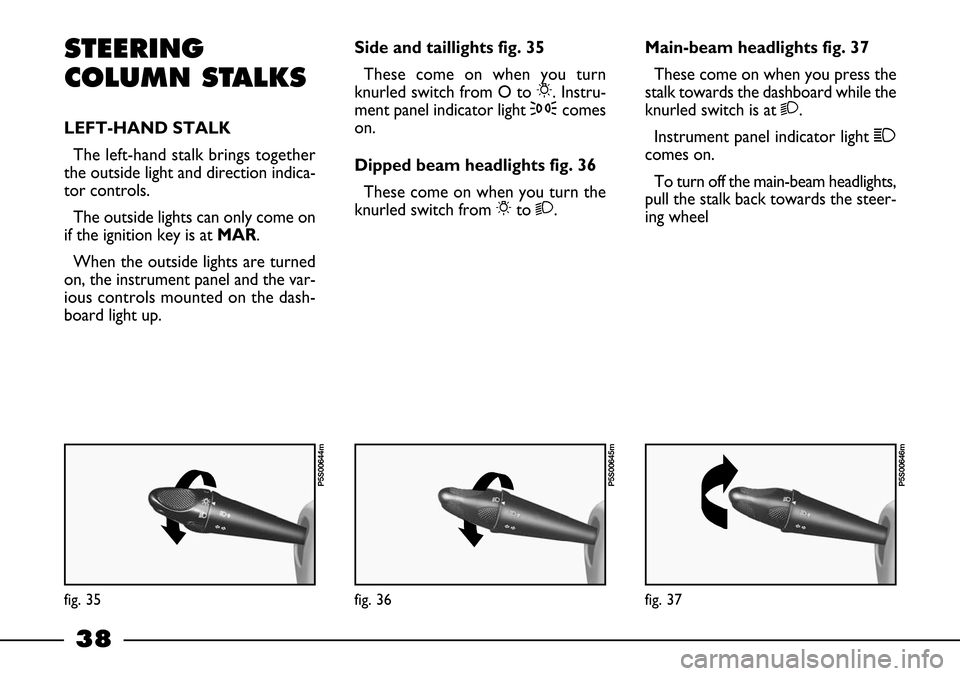
38
STEERING
COLUMN STALKS
LEFT-HAND STALK
The left-hand stalk brings together
the outside light and direction indica-
tor controls.
The outside lights can only come on
if the ignition key is at MAR.
When the outside lights are turned
on, the instrument panel and the var-
ious controls mounted on the dash-
board light up.Side and taillights fig. 35
These come on when you turn
knurled switch from O to 6. Instru-
ment panel indicator light 3comes
on.
Dipped beam headlights fig. 36
These come on when you turn the
knurled switch from 6to 2.Main-beam headlights fig. 37
These come on when you press the
stalk towards the dashboard while the
knurled switch is at 2.
Instrument panel indicator light 1
comes on.
To turn off the main-beam headlights,
pull the stalk back towards the steer-
ing wheel
fig. 35
P5S00644m
fig. 36
P5S00645m
fig. 37
P5S00646m
Page 40 of 170
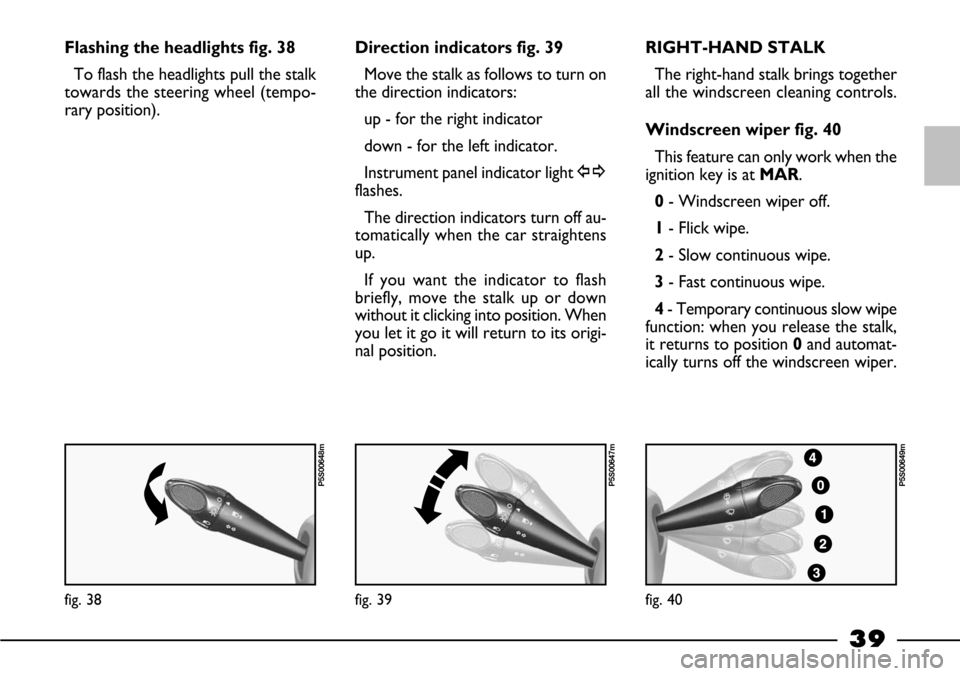
39
Flashing the headlights fig. 38
To flash the headlights pull the stalk
towards the steering wheel (tempo-
rary position).Direction indicators fig. 39
Move the stalk as follows to turn on
the direction indicators:
up - for the right indicator
down - for the left indicator.
Instrument panel indicator light y
flashes.
The direction indicators turn off au-
tomatically when the car straightens
up.
If you want the indicator to flash
briefly, move the stalk up or down
without it clicking into position. When
you let it go it will return to its origi-
nal position.RIGHT-HAND STALK
The right-hand stalk brings together
all the windscreen cleaning controls.
Windscreen wiper fig. 40
This feature can only work when the
ignition key is at MAR.
0- Windscreen wiper off.
1- Flick wipe.
2- Slow continuous wipe.
3- Fast continuous wipe.
4 - Temporary continuous slow wipe
function: when you release the stalk,
it returns to position 0and automat-
ically turns off the windscreen wiper.
fig. 38
P5S00648m
fig. 40
P5S00649m
fig. 39
P5S00647m
Page 41 of 170
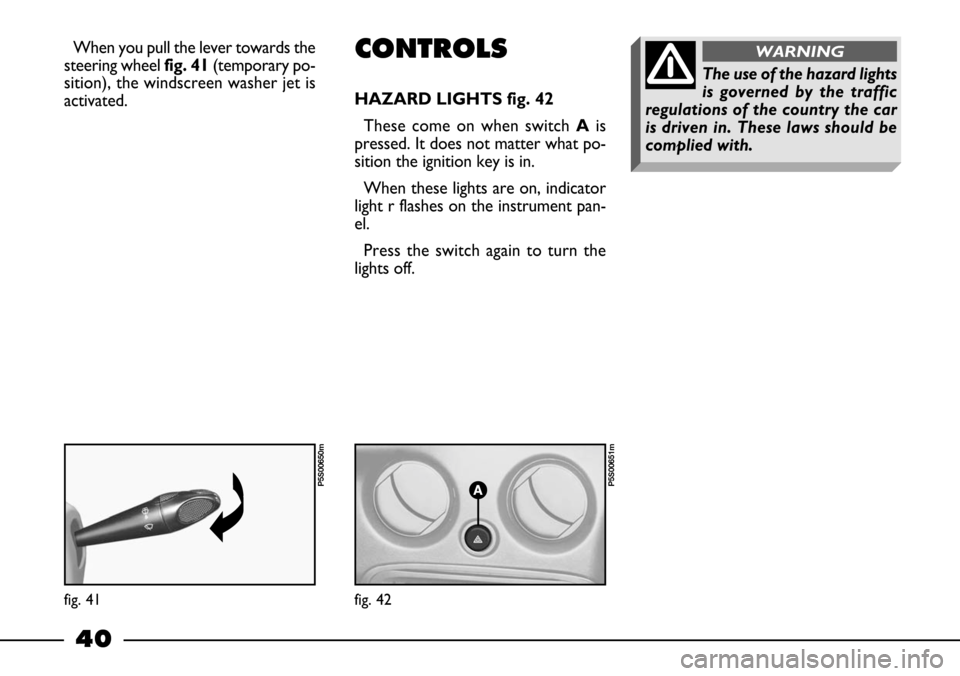
40
When you pull the lever towards the
steering wheel fig. 41(temporary po-
sition), the windscreen washer jet is
activated. CONTROLS
HAZARD LIGHTS fig. 42
These come on when switch Ais
pressed. It does not matter what po-
sition the ignition key is in.
When these lights are on, indicator
light r flashes on the instrument pan-
el.
Press the switch again to turn the
lights off.
fig. 41
P5S00650m
fig. 42
P5S00651m
The use of the hazard lights
is governed by the traffic
regulations of the country the car
is driven in. These laws should be
complied with.
WARNING
Page 57 of 170
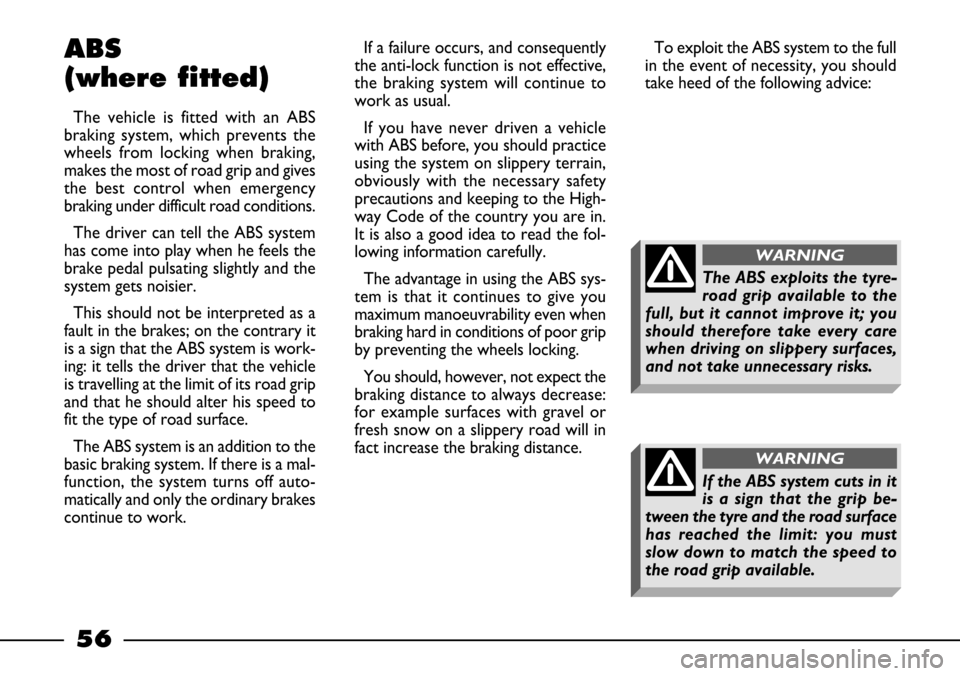
56
ABS
(where fitted)
The vehicle is fitted with an ABS
braking system, which prevents the
wheels from locking when braking,
makes the most of road grip and gives
the best control when emergency
braking under difficult road conditions.
The driver can tell the ABS system
has come into play when he feels the
brake pedal pulsating slightly and the
system gets noisier.
This should not be interpreted as a
fault in the brakes; on the contrary it
is a sign that the ABS system is work-
ing: it tells the driver that the vehicle
is travelling at the limit of its road grip
and that he should alter his speed to
fit the type of road surface.
The ABS system is an addition to the
basic braking system. If there is a mal-
function, the system turns off auto-
matically and only the ordinary brakes
continue to work.If a failure occurs, and consequently
the anti-lock function is not effective,
the braking system will continue to
work as usual.
If you have never driven a vehicle
with ABS before, you should practice
using the system on slippery terrain,
obviously with the necessary safety
precautions and keeping to the High-
way Code of the country you are in.
It is also a good idea to read the fol-
lowing information carefully.
The advantage in using the ABS sys-
tem is that it continues to give you
maximum manoeuvrability even when
braking hard in conditions of poor grip
by preventing the wheels locking.
You should, however, not expect the
braking distance to always decrease:
for example surfaces with gravel or
fresh snow on a slippery road will in
fact increase the braking distance.To exploit the ABS system to the full
in the event of necessity, you should
take heed of the following advice:
The ABS exploits the tyre-
road grip available to the
full, but it cannot improve it; you
should therefore take every care
when driving on slippery surfaces,
and not take unnecessary risks.
WARNING
If the ABS system cuts in it
is a sign that the grip be-
tween the tyre and the road surface
has reached the limit: you must
slow down to match the speed to
the road grip available.
WARNING
Page 58 of 170
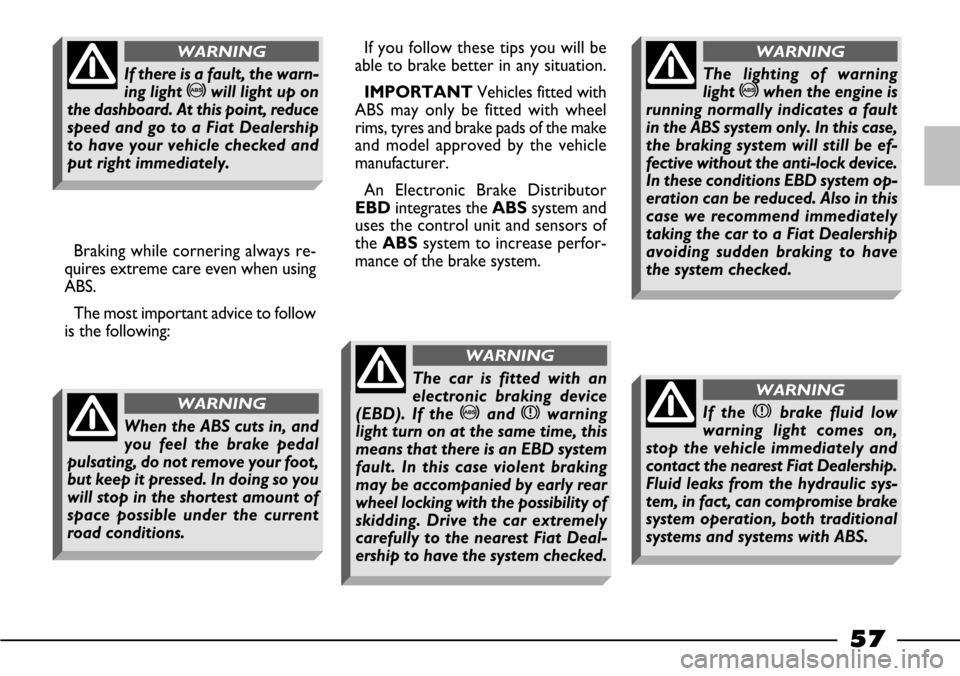
57
Braking while cornering always re-
quires extreme care even when using
ABS.
The most important advice to follow
is the following:If you follow these tips you will be
able to brake better in any situation.
IMPORTANTVehicles fitted with
ABS may only be fitted with wheel
rims, tyres and brake pads of the make
and model approved by the vehicle
manufacturer.
An Electronic Brake Distributor
EBD integrates the ABSsystem and
uses the control unit and sensors of
theABSsystem to increase perfor-
mance of the brake system.
If there is a fault, the warn-
ing light >will light up on
the dashboard. At this point, reduce
speed and go to a Fiat Dealership
to have your vehicle checked and
put right immediately.
WARNING
When the ABS cuts in, and
you feel the brake pedal
pulsating, do not remove your foot,
but keep it pressed. In doing so you
will stop in the shortest amount of
space possible under the current
road conditions.
WARNING
The car is fitted with an
electronic braking device
(EBD). If the >and xwarning
light turn on at the same time, this
means that there is an EBD system
fault. In this case violent braking
may be accompanied by early rear
wheel locking with the possibility of
skidding. Drive the car extremely
carefully to the nearest Fiat Deal-
ership to have the system checked.
WARNING
The lighting of warning
light >when the engine is
running normally indicates a fault
in the ABS system only. In this case,
the braking system will still be ef-
fective without the anti-lock device.
In these conditions EBD system op-
eration can be reduced. Also in this
case we recommend immediately
taking the car to a Fiat Dealership
avoiding sudden braking to have
the system checked.
WARNING
If the xbrake fluid low
warning light comes on,
stop the vehicle immediately and
contact the nearest Fiat Dealership.
Fluid leaks from the hydraulic sys-
tem, in fact, can compromise brake
system operation, both traditional
systems and systems with ABS.
WARNING
Page 59 of 170
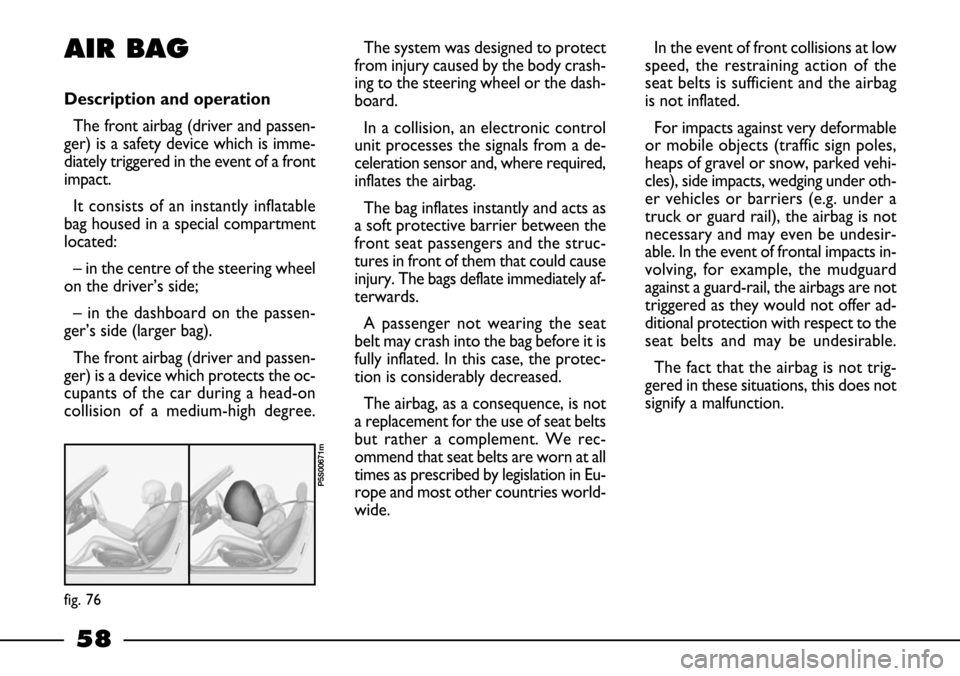
58
AIR BAG
Description and operation
The front airbag (driver and passen-
ger) is a safety device which is imme-
diately triggered in the event of a front
impact.
It consists of an instantly inflatable
bag housed in a special compartment
located:
– in the centre of the steering wheel
on the driver’s side;
– in the dashboard on the passen-
ger’s side (larger bag).
The front airbag (driver and passen-
ger) is a device which protects the oc-
cupants of the car during a head-on
collision of a medium-high degree. The system was designed to protect
from injury caused by the body crash-
ing to the steering wheel or the dash-
board.
In a collision, an electronic control
unit processes the signals from a de-
celeration sensor and, where required,
inflates the airbag.
The bag inflates instantly and acts as
a soft protective barrier between the
front seat passengers and the struc-
tures in front of them that could cause
injury. The bags deflate immediately af-
terwards.
A passenger not wearing the seat
belt may crash into the bag before it is
fully inflated. In this case, the protec-
tion is considerably decreased.
The airbag, as a consequence, is not
a replacement for the use of seat belts
but rather a complement. We rec-
ommend that seat belts are worn at all
times as prescribed by legislation in Eu-
rope and most other countries world-
wide. In the event of front collisions at low
speed, the restraining action of the
seat belts is sufficient and the airbag
is not inflated.
For impacts against very deformable
or mobile objects (traffic sign poles,
heaps of gravel or snow, parked vehi-
cles), side impacts, wedging under oth-
er vehicles or barriers (e.g. under a
truck or guard rail), the airbag is not
necessary and may even be undesir-
able. In the event of frontal impacts in-
volving, for example, the mudguard
against a guard-rail, the airbags are not
triggered as they would not offer ad-
ditional protection with respect to the
seat belts and may be undesirable.
The fact that the airbag is not trig-
gered in these situations, this does not
signify a malfunction.
fig. 76
P5S00671m